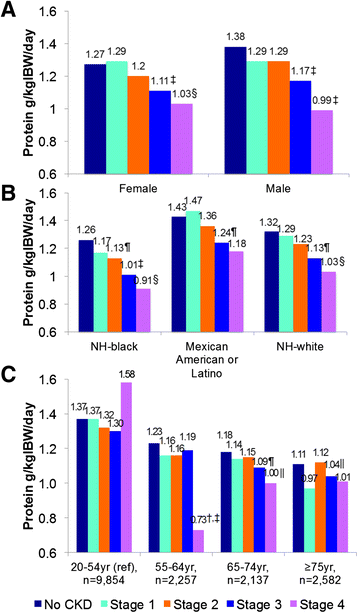North American experience with Low protein diet for Non-dialysis-dependent chronic kidney disease
- PMID: 27435088
- PMCID: PMC4952055
- DOI: 10.1186/s12882-016-0304-9
North American experience with Low protein diet for Non-dialysis-dependent chronic kidney disease
Abstract
Whereas in many parts of the world a low protein diet (LPD, 0.6-0.8 g/kg/day) is routinely prescribed for the management of patients with non-dialysis-dependent chronic kidney disease (CKD), this practice is infrequent in North America. The historical underpinnings related to LPD in the USA including the non-conclusive results of the Modification of Diet in Renal Disease Study may have played a role. Overall trends to initiate dialysis earlier in the course of CKD in the US allowed less time for LPD prescription. The usual dietary intake in the US includes high dietary protein content, which is in sharp contradistinction to that of a LPD. The fear of engendering or worsening protein-energy wasting may be an important handicap as suggested by a pilot survey of US nephrologists; nevertheless, there is also potential interest and enthusiasm in gaining further insight regarding LPD's utility in both research and in practice. Racial/ethnic disparities in the US and patients' adherence are additional challenges. Adherence should be monitored by well-trained dietitians by means of both dietary assessment techniques and 24-h urine collections to estimate dietary protein intake using urinary urea nitrogen (UUN). While keto-analogues are not currently available in the USA, there are other oral nutritional supplements for the provision of high-biologic-value proteins along with dietary energy intake of 30-35 Cal/kg/day available. Different treatment strategies related to dietary intake may help circumvent the protein- energy wasting apprehension and offer novel conservative approaches for CKD management in North America.
Keywords: CKD; Dietary protein intake; Dietary restriction; Low protein diet; Nutritional management.
Figures


References
-
- Klahr S, Levey AS, Beck GJ, Caggiula AW, Hunsicker L, Kusek JW and Striker G. The effects of dietary protein restriction and blood-pressure control on the progression of chronic renal disease. Modification of Diet in Renal Disease Study Group. N Engl J Med. 1994;330(13):877–84. Epub 1994/03/31. doi: 10.1056/NEJM199403313301301. URL: http://www.ncbi.nlm.nih.gov/pubmed/8114857. - PubMed
-
- Cooper BA, Branley P, Bulfone L, Collins JF, Craig JC, Fraenkel MB, Harris A, Johnson DW, Kesselhut J, Li JJ, Luxton G, Pilmore A, Tiller DJ, Harris DC, Pollock CA, Study I. A randomized, controlled trial of early versus late initiation of dialysis. N Engl J Med. 2010;363(7):609–19. doi: 10.1056/NEJMoa1000552. - DOI - PubMed
Publication types
MeSH terms
Substances
Grants and funding
LinkOut - more resources
Full Text Sources
Other Literature Sources
Medical

